Several years ago, I set out to understand the movements of the British army through Delaware and into Pennsylvania in early September 1777. It was a small piece of the Philadelphia campaign of Gen, Sir William Howe, who led a combined army of about 16,000 that landed on Elk Neck on August 25 and captured Philadelphia by mid-October. The campaign is probably best known for the engagements at Brandywine Creek and at Germantown.
I was most interested in September 8 through 10, when the British and Hessian troops moved from Pencader, Delaware, to Kennett Square in Pennsylvania, a movement that took them within a mile or so from my former home. There are quite a few records of this period, mostly among British and Hessian sources, but no one in recent times had done an accurate job of actually drawing it on today’s map. I was able to find the headquarters of General Howe on September 8 and 9 and used a sketch made by Capt. John André to locate the encampment along the Limestone Road, and thus could map the British movements.[1] Once properly oriented, the narratives all made sense. It dovetailed with work being done by researchers in Chester County, Pennsylvania, and for the Brandywine Battlefield, kudos to them.
What this research confirmed was an event on September 8 that should be recognized as a meaningful part of Delaware’s Revolutionary War history. It’s easy to believe that September 8 was simply a day of maneuver, and for the most part it was. Howe did not attack the Continentals entrenched behind Red Clay Creek, instead headed north to flank them in an extraordinary march that moved his entire army fourteen miles northward in about twenty-four hours. The armies met later at Brandywine Creek on September 11.
The British and Hessian maneuvers kept the Continentals in their fortified lines for the entire day, with one exception—one Continental brigade marched forward to near Mill Creek. The British occupied the hillside to the west of Mill Creek, in a line that extended up the Limestone Road almost five miles from near Milltown to New Garden, Pennsylvania. The Continental brigade of Gen. George Weedon made contact with the Hessian Jӓger Corps across a steep valley on Mill Creek, near today’s Delcastle Recreation Area. This foray is reported by sources on both sides, and the location is clear.
During this contact, the Jӓgers got off several shots with their amusettes, light field cannons also known as 1-pounder. And this story is about a one pound cannonball found in 1992 in a small creek in the Hyde Park neighborhood[2], well behind the Continental brigade but in a direct line of fire from the Jӓger amusettes through the Continental position at Delcastle. It’s too far away to be a direct shot. You can believe it or not, but the distance was likely due to at least one incredible bounce.
The Contact
The British troops, coming from Newark and Christina Bridge, reached the Limestone Road before noon. Captain Friedrich von Muenchhausen, an aide to General Howe, wrote,
We saw two regiments coming from Newport on two different roads . . . I was ordered by the General . . . to lead the Hessian Jaegers diagonally through the woods to cut off these troops . . . but the rebels . . . retreated quickly. Notwithstanding this, the jaegers got close enough to send a few amusette balls at them.[3]
Based on a diagram of the British camp on September 8 sketched by Captain André[4], the Jӓgers (called Chasseurs on his map[5]) were probably on the hillside above Henry Brackin’s house (now Limestone Hills), and were pushed forward to the hilltop that is now the Northpointe development just south of Stoney Batter Road.
On the opposite hillside, across Mill Creek and on the farm of the Samuel Fulton family, there arrived a brigade of Continentals under Gen. George Weedon. Lieutenant James McMichael of the Pennsylvania Line, in his diary, described how the Continentals were drawn up in line of battle behind Red Clay Creek on the morning of September 8. Then,
Here we remained for some time, when Gen. Weedon’s brigade (of which my regiment was a part) was detached to the front to bring on the attack. We crossed the creek and marched about a league to an eminence near Mr. McCannon’s meeting house [now Red Clay Creek Presbyterian Church], and there awaited the approach of the enemy, who were within half a mile of us. They however, encamped, which occasioned us to remain under arms all night, the sentries keeping up a constant fire.[6]
What neither of these accounts describes was that the Mill Creek valley separating the forces was probably wooded and dropped down steeply about one hundred feet on both sides; an assault from either side was simply not possible. Their positions that afternoon are shown on the sketch below, with the Jӓgers firing left to right over Henry Brackin’s mill on Mill Creek, later the site of the Spring Grove mill.
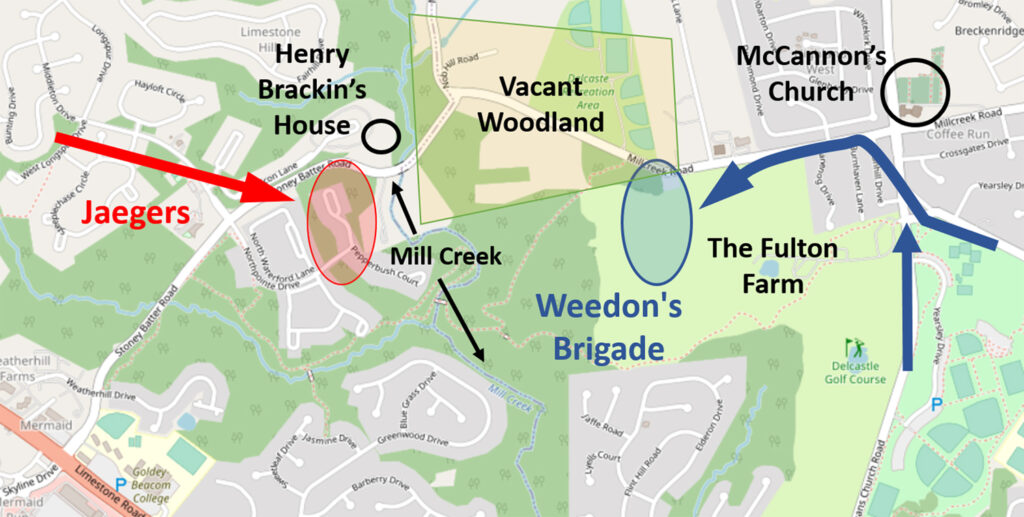
Fulton’s farm later became part of the New Castle County Workhouse, and is now a part of the county’s Delcastle Recreation Area. The Continentals could advance on a hilltop trail along the Fulton property line until the trail bent away to the right and followed a small valley down to Mill Creek, through a vacant tract. (A New Castle County road petition survey done in 1784 confirms this path, essentially the modern Mill Creek Road.) Patrols were probably sent forward through the trees and brush while regimental formations stayed on cleared land near the highest hilltop.
The Jӓger Amusettes
The mid 1700s saw a lot of conflict in Europe. Round ball ordnance of the American Revolution was generally derived from early cannon of that century, as well as changes and upgrades developed by all sides during the Seven Years War (including the French and Indian War of 1754 to 1763). This war also sowed the seeds for increased British taxation of its American colonies, and perhaps the Revolution itself.
Artillery was a practical rather than political art, and technology spread amongst allies. In a general way, technology and practitioners moved between Britain and its ally Prussia, while French technologists moved west into Denmark, Austria, and many small German states, even to Spain. This led to some standardization, as it was easier to copy technology rather than invent it. Cold hard experience helped drive the design of brass cannon into basic formulas for ball size (caliber), bore, length, and weight, and the ratios among these parameters were similar from 1-pound to 12-pound cannon. Not much was written down at the time; a book by John Muller printed in 1768 laments the lack of meaningful data available on the subject.[7] Later studies, written in the late eighteenth and early nineteenth centuries, are much more thorough and comprehensive—yet they are basically reporting on the same cannon types used during the American Revolution.
A cannon was always defined by its purpose; the amusette was a field gun. The artillerists dependent on field guns were focused on heavy 6-pound and 12-pound guns, and they tend to be what were described and reported on. Even the 3-pounders that might travel with a light infantry battalion required teams of horses for the piece and its caisson, but a 1-pound gun? It was simply a novelty or distraction to most artillerists, and thus was christened “amusette.”
The first amusette was mentioned in about 1741 in France, a one-inch bore wall gun mounted on a carriage. These were pulled from service a few years later. But by the 1750s the French artillerist Philippe Joseph, comte von Rostaing, while deployed to India, developed a 1-pound brass cannon that used a limonier for a carriage—a light two-pole harness that could be pulled by one horse or several men.[8] The 1-pounder had a bore of slightly over two inches.
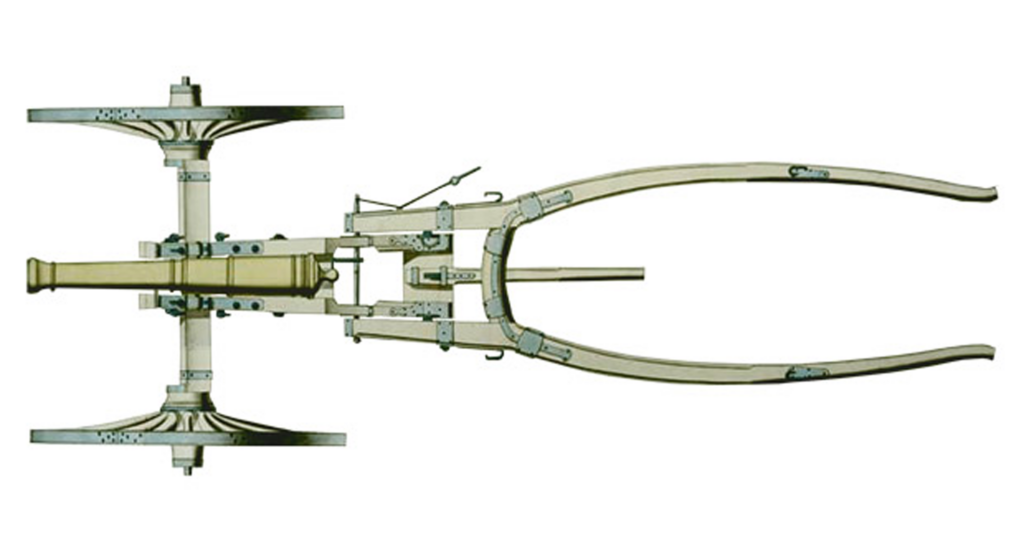
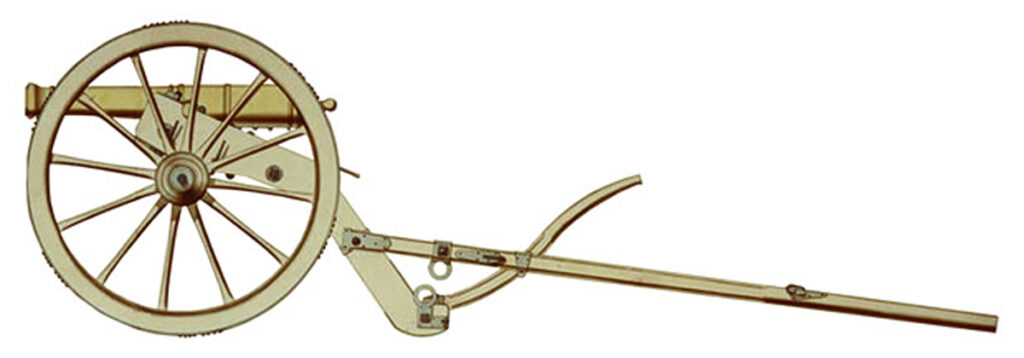
Rostaing’s amusette was a contemporary of light 4-pounders in the French arsenal referred to as à la suédoise, or of Swedish design. It is believed the 1-pounder had low recoil and a range comparable to the 4-pounder, and Rostaing even proposed to replace the 4-pounders with his amusette.[9] This 1-pounder amusette, officially introduced in 1757, had a bore of approximately 53 mm and a bore length of 20.6 calibers or about 110 cm. This ratio of bore to tube length was typical of early field artillery.
It is believed that forges in Austria, Denmark, and many German provinces, all allies of France, embraced the brass amusette at least on a small scale.[10] There is a record of amusettes captured by Prussia from Saxony in 1756.[11] In 1808, the Swedes captured an amusette from Norwegian Jӓgers, and that cannon is preserved at the Swedish Armémuseum.[12] It was forged in Denmark about 1768 (forty years before its capture), and it should be typical of the amusettes held by Hesse-Cassel that were shooting at Weedon’s Brigade.

The amusette at the museum has a bore of 55 mm and a bore length of about 21 calibers or 115 cm, again the typical barrel proportions for field cannon of that era. It allowed for several degrees of elevation but exactly how far is uncertain. And determining the range of this gun is problematic, simply due to the limited data. Clearly, the amusette was a “man-portable” cannon with a 2-inch ball, something that gave the Jӓgers a little extra “pop” when needed.
As for the presence of the amusettes, it was established in the “treaties” between Britain and Hesse-Cassel that two Jӓger companies traveling to America each had two light artillery pieces.[13] One of those companies was with General Howe on September 8, and in the right place according to André’s diagram.
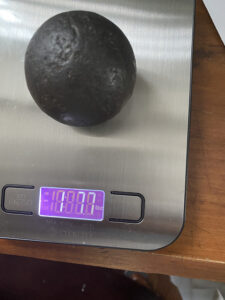
There is confirmation in an account signed by Gen. Leopold Philip von Heister, overall commander of the Hessian troops in America, to his superiors back in Germany. Written by a staff member and translated in the early twentieth century, it describes aspects of the engagement on September 3 between Jӓgers and General Maxwell’s Continentals near Iron Hill. The account states, “The Jaegers loss in this attack was one death, and eight severely and ten slightly wounded. Among these were two Artillery men and two Grenadiers (which had been detached to the Amusettes) as also one Corporal and one Jaeger of the Anspachers Company who were with them.”[14] There is no clear indication that the amusettes were actually deployed near Iron Hill, but they were an obvious target for Maxwell’s light troops that day.
The cannonball of this story was found in a stream by a three or four year old boy near Delcastle in 1992. It is about 2 1/8 inches or 54 mm in diameter and weighs 1 pound 7.7 ounces (1.48 pounds), indicating it was wrought iron (hammered) and not the lighter cast iron. Its size is consistent with a cannon such as the one above—a 54 mm ball in a 55 mm gun gives a gap or windage of 1 mm, within the 2 mm specification of that time.[15] It certainly fits the description of an amusette ball. But if this cannonball came from a Jaeger amusette, it’s a heck of a long shot. The ball was found about 8,500 feet or 1.6 miles from the Jaeger position, fired through or over the Continentals.
Artillery Data
Some readers like hard data, others less so, but to understand this cannonball we have to dig in to the “numbers” that we can find. Ballistics equations from physics class are only so helpful, as air resistance or drag had a very significant effect. Drag was not something the early gunners could calculate, it had to be learned. Of course, the bounce mattered as well.
There is some early data on cannon range, but as Muller advised, it doesn’t give ball weight, charge, or elevation, and these are all elements that affect the shot. There is little data for a 1-pounder; we’re left assuming that 3-pounder, 4-pounder, and 6-pounder data will have to do. But most importantly, field artillery against infantry or cavalry was all about bouncing or skipping the shot along the ground to mow down the adversary, called the ricochet shot. High angle shots that just buried themselves three feet into the ground served little purpose.
Muller referred to very early writings of St. Remy, “said to be the oldest upon record. It is easily perceived, that no dependence can be had on these experiments.” But despite his skepticism, he provided the data anyway, noting a “Point Blank” range of 150 paces and an “At Random” range of 1,500 paces for a 4-pound gun.[16] “Point Blank” referred to a gun at zero elevation; “At Random” could be any elevation above that. Using a 4-pound gun as representative of an amusette, the 1,500 paces is at least 3,750 feet, almost three-quarters of a mile.
A second source is a 1957 work by Hans Bleckwenn based on work of German historians from 1842 and 1844.[17] Bleckwenn’s focus was Prussian artillery in the Seven Years War, and he mentions the 1-pounder amusettes in Prussian service in that era. Bleckwenn borrows from Curt Jany, another German historian writing in 1928, that a 3-pounder of 1747 vintage was tested at 300 paces fired horizontally, and at 1,500 paces fired at 45 degrees elevation. In this case, the Prussian “pace” was about 2.4 feet, so these reported ranges may be close to 725 and 3,600 feet.[18]
The third source is a history of the Wurtemberg artillery written in 1882. On ranges for round shot in the 1790s, it says that the maximum range of a 3-pounder was 1,200 paces (3,000 feet). It further reports on test shoots from 1803 where a 6-pounder ranged to 1,300 paces (3,250 feet) first strike, and the shot rolled on (ricocheted) to 2,200 paces (5,500 feet). No other description of elevation or powder charge is given.[19]
Rigorous data on round ball cannon range appeared in the early nineteenth century, and was variously captured by several sources: “Handbuch der Artillerie” by Scharnhorst (1793), Adye’s “Pocket Gunner” (1804—1830’s), and “The Elements of the Science of War, Vol. III” by William Müller (1811). Scharnhorst was referenced by Adye and Müller; Adye and Müller also referenced one another. So while the primary source is fuzzy, it is Müller who gave the first credible and quantified description of the ricochet shots of field artillery. All generally gave an average distance of about 3,750 feet to “first graze” for the smaller caliber cannon.
There is remarkable research recorded by the Prussian military historian Karl von Decker in 1823. He wrote in detail of very rigorous testing of a British 6-pound gun performed in 1822. Over eighty rounds were fired and measured; he gave an average “first graze” at about 3,150 feet for 3.25 deg elevation, and about 3,520 feet for 4 degree elevation. The longest shot at 4 degree elevation traveled 4,100 feet first graze.[20]
During these tests, the distances between grazes were also measured. Von Decker reported:
- At 4 degree elevation, the second graze averaged almost 700 feet, while one bounced almost 900 feet.
- Some shots went for seven or more grazes, some traveled beyond the one mile test range.
- While conventional wisdom said that the distance between grazes should decrease, the data showed more shots actually had grazes that became longer rather than shorter.
- The notion that higher gun elevation should on average result in shorter and fewer grazes was also refuted.
Von Decker’s results overturned some conventional wisdom, and in a general sense it demonstrated that any specific shot could dissipate its kinetic energy in very unpredictable ways.
Topography And “The Shot”
To understand the shot that landed our cannonball so far away from its source, one has to next understand the topography. The evidence suggests at least one Jӓger amusette reached the firing position shown in Figure 6, at left. A nearly straight trajectory is offered here, extending about 8,500 feet to where the ball was found. At the far end is a possible landing zone, whereby the ball may have bounced, rolled, or slowly washed down a long hillside to its final resting place. The shot could have veered left or right.
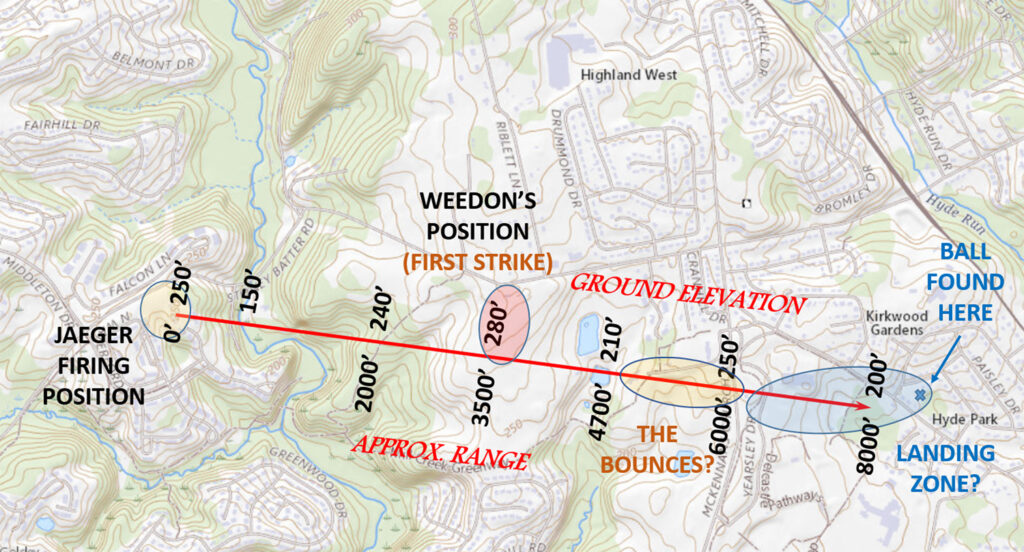
Following the ground elevations, the ball had to reach the 280-foot hilltop at about 3,500 feet distant, which was reasonably in range for the amusette assuming the gunner knew how best to use his charge, his gun elevation, and the heavier ball. As the first hilltop was at a higher elevation than the gun, the ball may have struck the hilltop at a shallower angle and therefore ricocheted further.
Beyond 3,500 feet is another small valley dropping to about 210 feet; any ball on first strike or bounce that landed there (3,500 to about 5,000 feet) would not have bounced out. For any ball to continue its trajectory, it would need to clear the next high point on the current McKennan’s Church Road, a 250-foot elevation about 6,000 feet distant. This requires a first bounce of at least 1,500 feet—it’s a long way, but to a lower elevation—and then another bounce of 1,000 feet, or maybe several more skips. It’s all downhill from McKennan’s Church Road down to the creek where the ball was found. That last travel could have taken two centuries for all we know.
So the shot is possible if not probable to our senses. Much of our take on history is conjecture, hopefully supported by sound theory and research. I can’t prove the Delcastle cannonball came from a Hessian amusette, but I believe the story is credible. Locations, armaments, the ball, and the narratives are consistent. Prior research independently puts the Jӓgers and Weedon on these two hilltops and we know that the amusettes were used.
I have looked for another explanation for the ball and I can’t find one. The Continentals had no reason to be carrying 2-inch cannonballs at that location and in that era. There is no evidence to believe it is a Civil War relic. We know almost exactly where the ball was found, by a young child who can’t be accused of any guile or intrigue regarding its location. Any alternative theories must pass the test of Occam’s razor—what is the simplest explanation?
Somehow the shot made it. I believe this cannonball is genuine evidence of the British presence in Delaware in September 1777. And it’s been reasonably pointed out to me that Weedon’s position was the closest eyes and ears that General Washington had on the British movements that afternoon and evening. There are stories that Washington himself visited nearby Milltown and possibly a “Council Oak” near Brandywine Springs the evening of September 8, perhaps to meet with Weedon or his aides.
The knowledge that the British units “encamped” was critical intelligence that sent the entire Continental army marching to John Chad’s ford on the Brandywine just a few hours later, about 2am on September 9. If Howe had crossed the Brandywine Creek uncontested, the Continentals could have been trapped with their backs against the Delaware River, already controlled by the British fleet. From a strategic standpoint, Weedon’s foray with its Delcastle cannonball was a very significant military event in Delaware.
[1]Walter Chiquoine, Finding the Daniel Nichols House: a New Interpretation of the British March Through Mill Creek Hundred, www.academia.edu/26580954/FINDING_THE_DANIEL_NICHOLS_HOUSE_A_NEW_INTERPRETATION_OF_THE_BRITISH_MARCH_THROUGH_MILL_CREEK_HUNDRED.
[2]The News Journal, July 15, 1993.
[3]Ernst Kipping, At General Howe’s Side 1776-1778, a translation of the diary of Captain Friedrich von Muenchhausen (Monmouth Beach, NJ: Philip Freneau Press, 1974), 30.
[4]Major John André, “Position of the Army at New Garden the 8thSept. 1777 [Map]”, Major André’s Journal: Operations of the British Army under the Lieutenant Generals Sir William Howe and Sir Henry Clinton, June 1777 to November 1778 (Boston: Bibliophile Society, 1903).
[5]Jӓgers, also written Jaegers or Yagers, also called Chasseurs by the French, were skilled woodsmen and marksmen, armed with rifle and small sword, self-reliant and capable of working in small units.
[6]“Diary of Lieutenant James McMichael of the Pennsylvania Line, 1776-1778,”Pennsylvania Archives Vol. 15, Series 2 (Harrisburg, PA: E. K. Myers, 1890), 210.
[7]John Muller, A Treatise of Artillery (2nd Ed.) (London: John Millan, 1768), viii.
[8]Stephen Summerfield, “M1732 Vallière System (1732-1765),” Smoothbore Ordnance Journal issue 4 (June 2012), www.napoleon-series.org/military-info/OrdnanceJournal/Issue4/SOJ_4-2b-Valliere.pdf, 44.
[9]Jean-Louis Vial (2012), “French Artillery à la Rostaing,” www.kronoskaf.com/syw/index.php?title=French_Artillery_%C3%A0_la_Rostaing.
[11]Hans Bleckwenn, “Prussian Field Gun Models 1756-1762 in Relation to General Tactics,” translated by Digby Smith, Smoothbore Ordnance Journalissue 6 (March 2013), www.napoleon-series.org/military-info/OrdnanceJournal/Issue6/SOJ-6-1_Bleckwenn.pdf.
[12]Swedish Armémuseum, digitaltmuseum.se/011024265642/1-pundig-kanon.
[13]Bernhard A. Uhlendorf, trans., Revolution in America: Confidential Letters and Journals 1776-1784 of Adjutant General Major Baurmeister of the Hessian Forces (New Brunswick, NJ: Rutgers University Press, 1957), 17.
[14]“Account of the North American War”, Letter AA Part 2, p. 70, Lidgerwood Collection of Hessian Transcripts, Morristown National Historic Park, Morristown, NJ.
[15]For example, see Stephen Summerfield, “Gribeauval Cannon 1765-1789,” Smoothbore Ordnance Journal issue 4 (June 2012), www.napoleon-series.org/military-info/OrdnanceJournal/Issue4/SOJ_4-2c-Gribeauval.pdf, 50.
[16]Muller, A Treatise of Artillery, p. viii.
[17]Bleckwenn, “Prussian Field Gun Models.”
[19]“Weissenbach‟s History of the Royal Württemberg Artillery—Organisation and Equipment 1734-1815,” Smoothbore Ordnance Journal issue 2 (December 2010), www.napoleon-series.org/military-info/OrdnanceJournal/Issue2/SOJ-0207.pdf, 75-82.
[20]”Prussian Tests of the British 6-pdr,” “Firing Roundshot from a British 6-pdr,” and “Ricochet Shots (‘Rollschüsse’) of British 6-pdr,” Smoothbore Ordnance Journal issue 7 (October 2013), www.napoleon-series.org/military-info/OrdnanceJournal/Issue7/SOJ-07_Part2_British_6-pdr.pdf, 41-61.





Recent Articles
Videau’s Bridge: An American Disaster After Yorktown
This Week on Dispatches: Geoffrey Hoerauf on American Spies around Fort Detroit
Lafayette and the Journey to Yorktown
Recent Comments
"The New Dominion: Virginia’s..."
Thanks, Eric! There's more to come on this. Three generations of my...
"The New Dominion: Virginia’s..."
Excellent overview of the convoluted system for awarding bounty lands during and...
"Vanishing Ranks: Rawlings’ Rifle..."
Good work here. This being one of the harder units to research,...